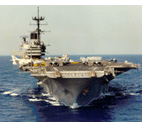BeirutDude
Posts: 2625
Joined: 4/27/2013
From: Jacksonville, FL, USA
Status: offline

|
quote:
ORIGINAL: Gunner98
Go big or stay home.
The trick with any modern SAM is to reduce the window of time it has to engage your missiles. You can do this by terrain masking your approach, using jammers, using decoys and/or just dumping missiles at it. All of the above is better.
If you can reduce the window by half with terrain masking and then a bit more with jamming and decoy a few missiles away you have a much better chance.
You only need one or two hits with an ARM or AARGM and follow up with CBU or iron bombs to take out the TELs
Edited..
To add to what Gunner said, don't forget to gradually bring your strike lower (below the game's radar horizon and to save fuel) as you approach the target and only pop up to acquire the target and launch last minute.
Real World: In most radar uses we simplify the radar beam solution by saying radar is straight line-Line of sight (standard refraction), and that is what the game does. In reality radar is not line of sight (at least all of the time). Like in ASW where you have bending of sound waves and convergence zones, the same applies to radar (well not convergence zones). They are called Super refractive and sub refractive conditions. In Sub refractive conditions the atmospheric conditions tend to bend the radar beam higher and away from the standard refraction and that will leave a hole (we called it a "Duct" but that isn't quite right as I later learned in college) that the aircraft can take advantage of to get closer to the target before firing. In the 1980s we used an early computer program called the Integrated Refractive Effects Prediction System (IREPS), that would forecast the radar profile based on the atmosphere, radar characteristics and especially the Band.
The opposite of Sub refractive conditions are super refractive conditions and that is when the beam is lower than the Standard Atmosphere. You can see Super refractive conditions in the winter when in the early morning hours the weather radar beams hit the ground and it looks like a nuclear weapon went off by the radar site. This also creates the same profile with a gap in coverage.
So what we would have to do is to run both the bad guy's (usually a Soviet/Warsaw Pact) defensive package (SA-2, SA-3, Sa-6, SA-13 sites and radars, etc.) AND also our radars so we knew where our emissions where going. Ever wonder about the timing of an airstrike, it is more than sleepy operators, and cover of night but also radar beam bending which is optimal in the predawn hours in temperate zones. The different Soviet radar types and bands made this very hard but not impossible.
So real operators have a few tricks up their sleeves we do not. I suspect this is in the Professional Edition, but for our purposes this is over simplified.
https://apps.dtic.mil/sti/citations/ADA169561
< Message edited by BeirutDude -- 11/15/2021 11:32:48 AM >
_____________________________
"Some people spend an entire lifetime wondering if they made a difference. The Marines don't have that problem."
PRESIDENT RONALD REAGAN, 1985
I was Navy, but Assigned TAD to the 24th MAU Hq in Beirut. By far the finest period of my service!
|
 Printable Version
Printable Version












 , of course the HARM missile that makes it through has a PoK that includes outright missing the target and malfunction. I don't know that I've ever seen an impacting HARM not kill the radar (dishes being easy to collapse) but I imagine it's possible to do damage and still have the radar operational? So I would suggest adding a few for those numbers (like 20 to 22 total HARMS) to account for those possibilities to ensure a kill.
, of course the HARM missile that makes it through has a PoK that includes outright missing the target and malfunction. I don't know that I've ever seen an impacting HARM not kill the radar (dishes being easy to collapse) but I imagine it's possible to do damage and still have the radar operational? So I would suggest adding a few for those numbers (like 20 to 22 total HARMS) to account for those possibilities to ensure a kill.  Good thing we can electronically saturate the target for $80 plus DLCs!
Good thing we can electronically saturate the target for $80 plus DLCs! 

 New Messages
New Messages No New Messages
No New Messages Hot Topic w/ New Messages
Hot Topic w/ New Messages Hot Topic w/o New Messages
Hot Topic w/o New Messages Locked w/ New Messages
Locked w/ New Messages Locked w/o New Messages
Locked w/o New Messages Post New Thread
Post New Thread